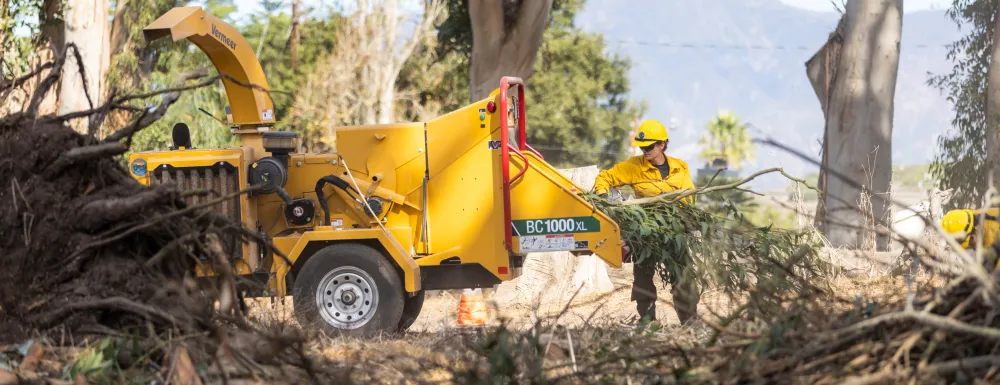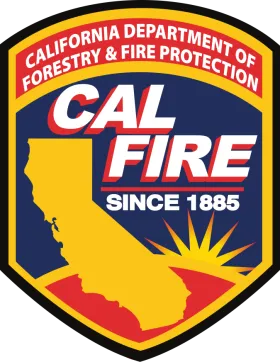Major Storm Forecast | Travelers should check directly with airlines for latest flight status.
All SBPL locations will be closed from 12/22 through 12/26 and on 1/1/26 for the winter holidays. For all the details about adjusted hours and closures, visit our Winter Holiday Hours page.
Contacts
Monique O'Conner
Open Space Planner
(805) 560-7576
MOConner@SantaBarbaraCA.gov
Mark vonTillow
Inspector III/Wildland Specialist
(805) 564-5720
MvonTillow@SantaBarbaraCA.gov
Wildfires pose a significant threat to Santa Barbara year-round. The Parks and Recreation Department and Fire Department have partnered to improve the community’s fire resilience and reduce the risk and severity of wildfires. The collaboration balances the expertise of both teams to manage vegetation while protecting the natural ecosystems within the city’s open space parks.
This work is a critical component of Santa Barbara’s Community Wildfire Protection Plan.
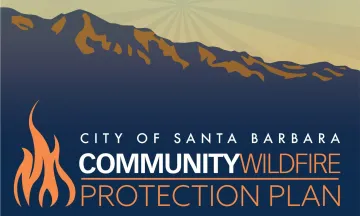
Learn more about the comprehensive plan to mitigate wildfire impacts throughout the City.
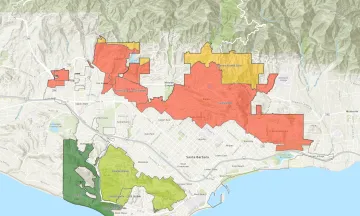
Use this interactive tool to identify if your property is located within the City's High Fire Hazard Area.
Priorities
Our collaborative efforts aim to reduce wildfire risk and improve fire resilience with five priorities in mind:
- Defensible Space: Creating and maintaining defensible space around homes located near open spaces to act as a protective barrier against wildfires.
- Fire Access Roads and Fuel Breaks: Ensuring efficient access to high fire hazard areas for rapid response.
- Vegetation Management: Targeting high-fire-risk invasive species to allow native, fire-resilient species to thrive.
- Fuel Load Reduction: Reducing fuel loads in high-risk areas to minimize the intensity and spread of wildfires.
- Community Outreach and Education: Raising awareness about the importance of fire safety and fostering a fire-resilient community.
Projects
Project Dates: October 2025 through December 2026
About the Park
Franceschi Park is an 18-acre open space located within the foothill zone of the high fire hazard area. The park is composed of four different vegetation communities: coast live oak woodland and forest, California sage scrub, eucalyptus groves, and wild oats and annual brome grassland.
Planned Work
Crews will remove invasive plants to restore native habitat and create a more fire-resilient landscape. The primary target is tree spurge (Euphorbia dendroides), a pervasive and challenging invasive plant found throughout the park.
Sensitive Resources
A biological resource assessment was performed and identified a variety of sensitive resources within the park.
One special-status wildlife species is known to be present within the park: yellow warbler. An additional 3 special status wildlife species have suitable habitat and are considered likely to be found within the preserve: Cooper’s hawk, sharp-shinned hawk, and Northern California legless lizard. No special status plant species or sensitive natural communities were identified within the park.
A pre-activity biological survey will occur within 10 days of the start of work for all special status species. Exclusion zones and a biological monitor were utilized to protect all special status species on site. Work was performed outside of nesting bird season.
All crew members received environmental awareness training before work began to review present sensitive resources and how to protect them.
Franceschi Park Biological Resource Assessment (November 2024)
Project Dates: December 2025 - January 2026
About the Park
Honda Valley Park is a 48-acre open space located within the coastal interior zone of the high fire hazard area. The park is composed of seven vegetation communities, the primary ones being oak woodland and eucalyptus grove.
Planned Work
Crews will be targeting deadwood and invasive species to reduce fuel loads in the park through weed whipping, hand cutting, hand pulling, chainsaw work, chipping, flattening, raking, shoveling, and bucking existing woody debris. The targeted invasive species include eucalyptus, ash, olive, Cape ivy, and French broom.
Crews will also focus on removing vegetation from trails and access roads, to maintain clear site access for emergency crews and vehicles in the event of a fire.
Sensitive Resources
A biological resource assessment was performed and identified a variety of sensitive resources within the park.
Four special status plant species were identified: Plummer’s Baccharis, Southern California black walnut, Santa Barbara honeysuckle, and bitter gooseberry.
Six special status wildlife species are considered likely to be found within the park: Cooper’s hawk, sharp-shinned hawk, California legless lizard, overwintering monarch butterfly, American peregrine falcon, and western red bat. A pre-activity biological survey will occur within 10 days of the start of work for all special status species. Exclusion zones and a biological monitor will be utilized as needed. Work will be performed outside of nesting bird season.
Two sensitive natural communities are present within the park: lemonade berry scrub shrublands and California sycamore – coast live oak riparian woodlands. No adverse impacts will be made to these communities and invasive vegetation that threatens these sensitive communities will targeted as part of planned work.
All crew members receive environmental awareness training before work begins to review present sensitive resources and how to protect them.
Honda Valley Park Biological Resource Assessment (August 2025)

Project Dates: September 2025 to December 2025
About the Park
Stevens Park is a 26-acre open space located within the foothill zone of the high fire hazard area. The park is primarily composed of two native vegetation communities: coast live oak woodland and California sycamore/coast live oak riparian woodland.
Completed Work
Crews targeted invasive species, downed trees, deadwood, and hazardous vegetation to reduce fuel loads through weed whipping, hand cutting, hand pulling, chainsaw work, chipping, and flattening. Targeted invasive species are primarily eucalyptus and acacia, but also include castor bean, cape ivy, olive, Peruvian peppertree, glossy privet, common fig, pride of madeira, fennel, and tree tobacco.
Clear site access for emergency crews was also maintained as part of this project.
Sensitive Resources
A biological resource assessment was performed and identified a variety of sensitive resources within the park.
One special-status wildlife species is known to be present within the park: monarch butterfly. An additional six special status wildlife species have suitable habitat and are considered likely to be found within the park: Cooper’s hawk, American peregrine falcon, yellow-breasted chat, western red bat, south coast garter snake, and Northern California legless lizard. Three special-status plant species are known to be present within the park: Plummer’s baccharis, Santa Barbara honeysuckle, and bitter gooseberry.
A pre-activity biological survey will occur within 10 days of the start of work for all special status species. Exclusion zones and a biological monitor will be utilized to protect all special status species on site. Most work will be performed outside of nesting bird season. If work must occur during the nesting bird season, a nesting bird survey will be performed ahead of planned work.
All crew members will receive environmental awareness training before work begins to review present sensitive resources and how to protect them.
Project Dates: April 2025 to June 2025
Completed Work
The City's Vegetation Management Crew worked in 16 parks, focusing on vegetation management where parkland serves as the buffer zone, also known as defensible space, between buildings and surrounding vegetation, that can help slow or stop the spread of wildfire. Crews targeted growing annuals, invasive species, downed trees, and deadwood to reduce fuel loads by weed whipping, mowing, hand cutting, hand pulling, chainsaw work, and chipping.
Crews also focused on trimming vegetation along front country trails and fire access roads, known as trail brushing, to maintain clear access for emergency vehicles and personnel in the event of a fire.
Locations
Arroyo Burro Open Space, Douglas Family Preserve, Elings Park, Franceschi Park, Hale Park, Hilda McIntyre Ray Park, Honda Valley Park, Laurel Canyon Park, Loma Media, Mission Historical Park, Orpet Park, Parma Park, Sheffield Reservoir, Skofield Park, Stevens Park, Sylvan Park.
Sensitive Resources
All crew members received environmental awareness training before work began to review present sensitive resources and how to protect them. Defensible space work is conducted ahead of the traditional high fire season, but within nesting bird season. A pre-activity and nesting bird survey occurred within 72 hours of the start of work. Exclusion zones were established, and a biological monitor was onsite as needed to protect active nests and sensitive species throughout the project.
Project Dates: December 2024 through January 2025
About the Park
Franceschi Park is an 18-acre open space located within the foothill zone of the high fire hazard area. The park is composed of four different vegetation communities: coast live oak woodland and forest, California sage scrub, eucalyptus groves, and wild oats and annual brome grassland.
Completed Work
Crews targeted invasive species, downed trees, deadwood, and hazardous vegetation to reduce fuel loads through weed whipping, hand cutting, hand pulling, chainsaw work, chipping, and flattening. Targeted invasive species included castor bean, young eucalyptus, tree spurge, olive, Peruvian peppertree, Brazilian pepper tree, onionweed, Spanish broom, and iceplant.
Crews also focused on trimming vegetation along designated walking paths, also known as trail brushing, to maintain clear site access for emergency crews in the event of a fire.
Sensitive Resources
A biological resource assessment was performed and identified a variety of sensitive resources within the park.
One special-status wildlife species is known to be present within the park: yellow warbler. An additional 3 special status wildlife species have suitable habitat and are considered likely to be found within the preserve: Cooper’s hawk, sharp-shinned hawk, and Northern California legless lizard. No special status plant species or sensitive natural communities were identified within the park.
A pre-activity biological survey occurred within 10 days of the start of work for all special status species. Exclusion zones and a biological monitor were utilized to protect all special status species on site. Work was performed outside of nesting bird season.
All crew members received environmental awareness training before work began to review present sensitive resources and how to protect them.
Franceschi Park Biological Resource Assessment (November 2024)
Franceschi Park Work Plan (March 2025)
Franceschi Park After Action Report (March 2025)
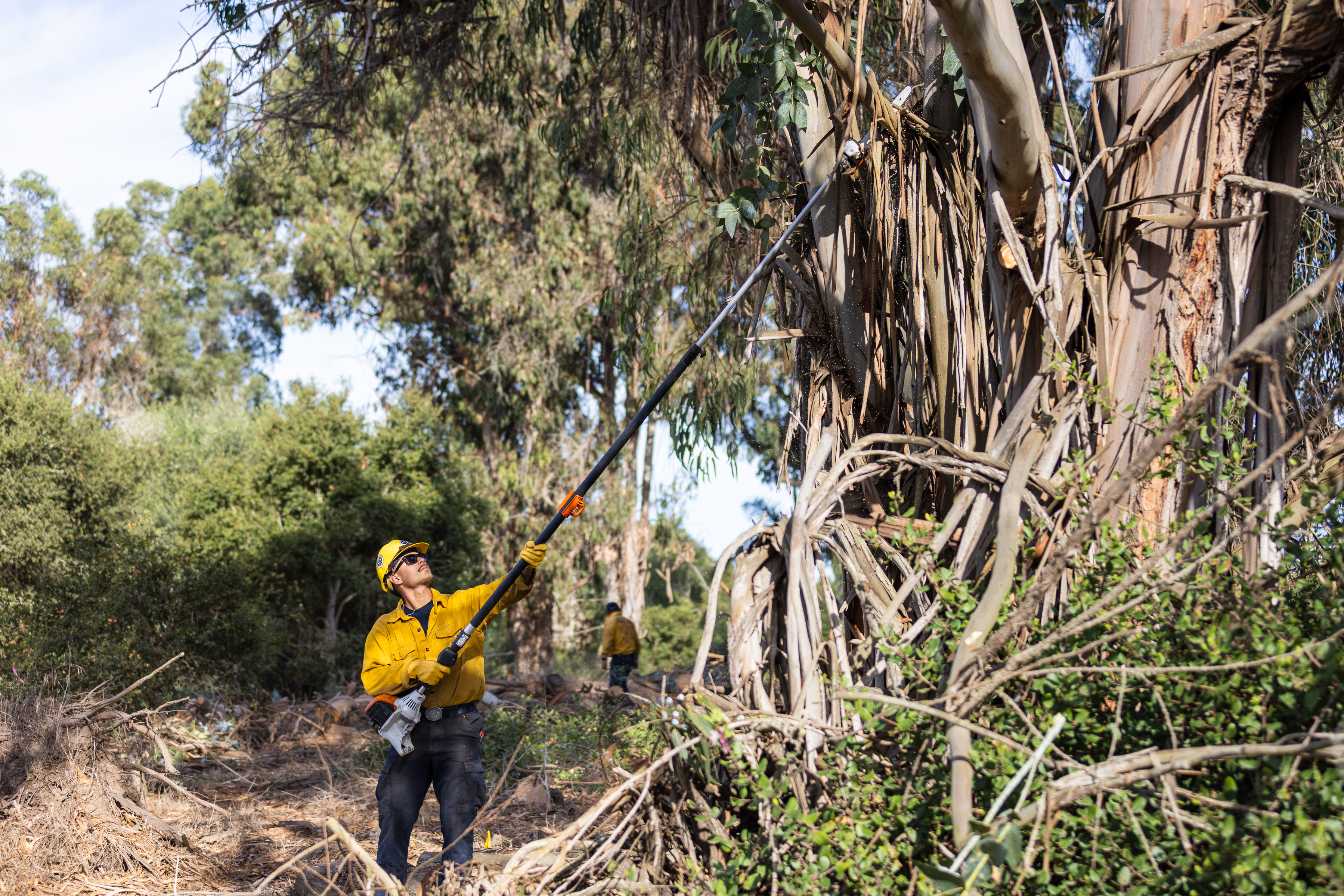
Project Dates: October 2024 through January 2025
About the Park
Douglas Family Preserve is a 70-acre open space located within the coastal zone of the high fire hazard area. The park is composed of fourteen different vegetation communities. The native coast live oak woodland and forest community makes up a majority of the park space, followed by the eucalyptus groves community.
Completed Work
Crews targeted invasive species, downed trees, and deadwood to reduce fuel loads through weed whipping, mowing, hand cutting, hand pulling, chainsaw work, chipping, flattening, raking, and shoveling. Targeted invasive species included acacia, castor bean, young eucalyptus, olive, lollypop tree, sections of dried radish/crown daisy, Taiwan firethorn, iceplant, and ash.
Crews also focused on trimming vegetation along designated primary trails, also known as trail brushing, to maintain clear site access for emergency crews and vehicles in the event of a fire.
Sensitive Resources
A biological resource assessment was performed and identified a variety of sensitive resources within the park.
Five special status plant species were identified: Plummer’s baccharis, Santa Barbara honeysuckle, Cliff malacotherix, woolly seablite, and bitter gooseberry.
Three special-status wildlife species are known to be present within the preserve: double-crested cormorant, brown pelican, and yellow warbler. An additional 23 special status wildlife species have suitable habitat and are considered likely to be found within the preserve: Cooper’s hawk, sharp-shinned hawk, Northern California legless lizard, willow flycatcher, western pond turtle, southern sea otter, tidewater goby, American peregrine falcon, common loon, pinto abalone, California gull, western red bat, long-billed curlew, steelhead – southern California Distinct Population Segment (DPS), osprey, two-striped gartersnake, south coast gartersnake, and least Bell’s vireo.
A pre-activity biological survey occurred within 10 days of the start of work for all special status species. Exclusion zones and a biological monitor were utilized to protect all special status species on site. Work was performed outside of nesting bird season.
Two sensitive natural communities are present within the preserve: salt marsh bulrush marshes and lemonade berry scrub. While the wooly seablite/cliff malacotherix provisional alliance is not a designated sensitive alliance evaluated by the California Native Plant Society, these dominant rare plants are still considered sensitive. No adverse impacts were made to these communities, and invasive vegetation that threatens these sensitive communities was targeted.
All crew members received environmental awareness training before work began to review present sensitive resources and how to protect them.
Douglas Family Preserve Biological Resource Assessment (February 2024)
Douglas Family Preserve Work Areas (September 2024)
Douglas Family Preserve Complete Work Area Descriptions (September 2024) - subject to change
Douglas Family Preserve Work Plan Final (February 2025)
Douglas Family Preserve After Action Report (February 2025)
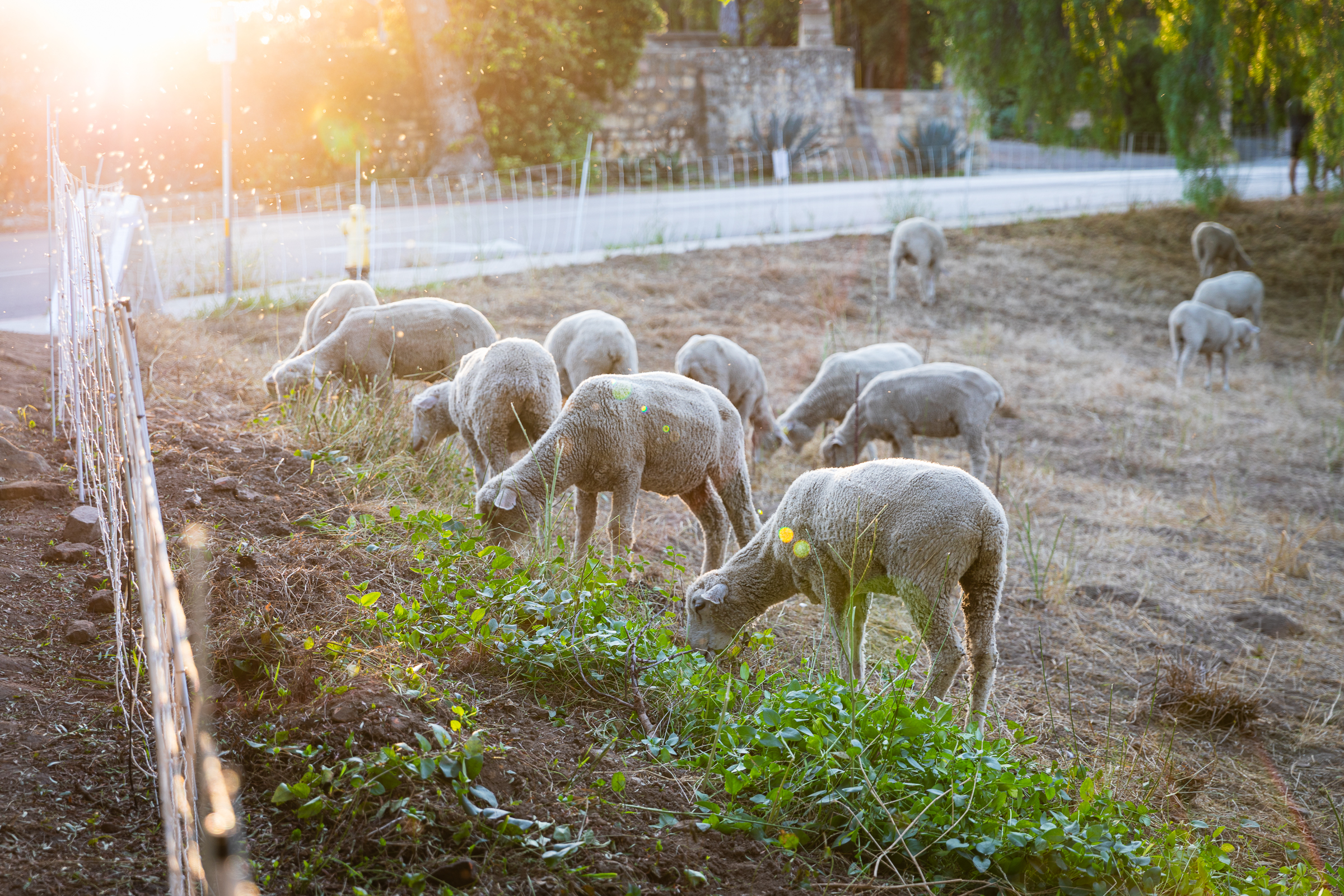
Project Dates: May 2024
Completed Work
A herd of sheep grazed approximately 15 acres across four parks prior to wildfire season. The project maintained defensible space between homes and parkland by removing overgrown grass and brush from the park properties. The grazing sheep travelled to Laurel Canyon Park, Hale Park, Franceschi Park, and Mission Historical Park. The herd spent a few days grazing in each location before moving to the next park.
Sensitive Resources
Grazers, including sheep and goats, have been used in City parks since 2015. While they are an effective tool to create defensible space, measures were taken to reduce their impact on sensitive biological resources within the parks. Before the herd’s arrival, a biologist surveyed each property for nesting birds, and flags and fencing were installed to protect sensitive plants, like young oak saplings, to ensure the sheep could not reach them. The order of the grazing schedule was designed to reduce the likelihood of introducing new invasive plants into any of the parks during the process, as the animals’ droppings can spread the seeds of the invasive plants. The city's Vegetation Management Crew manually cleared areas too sensitive for grazing.
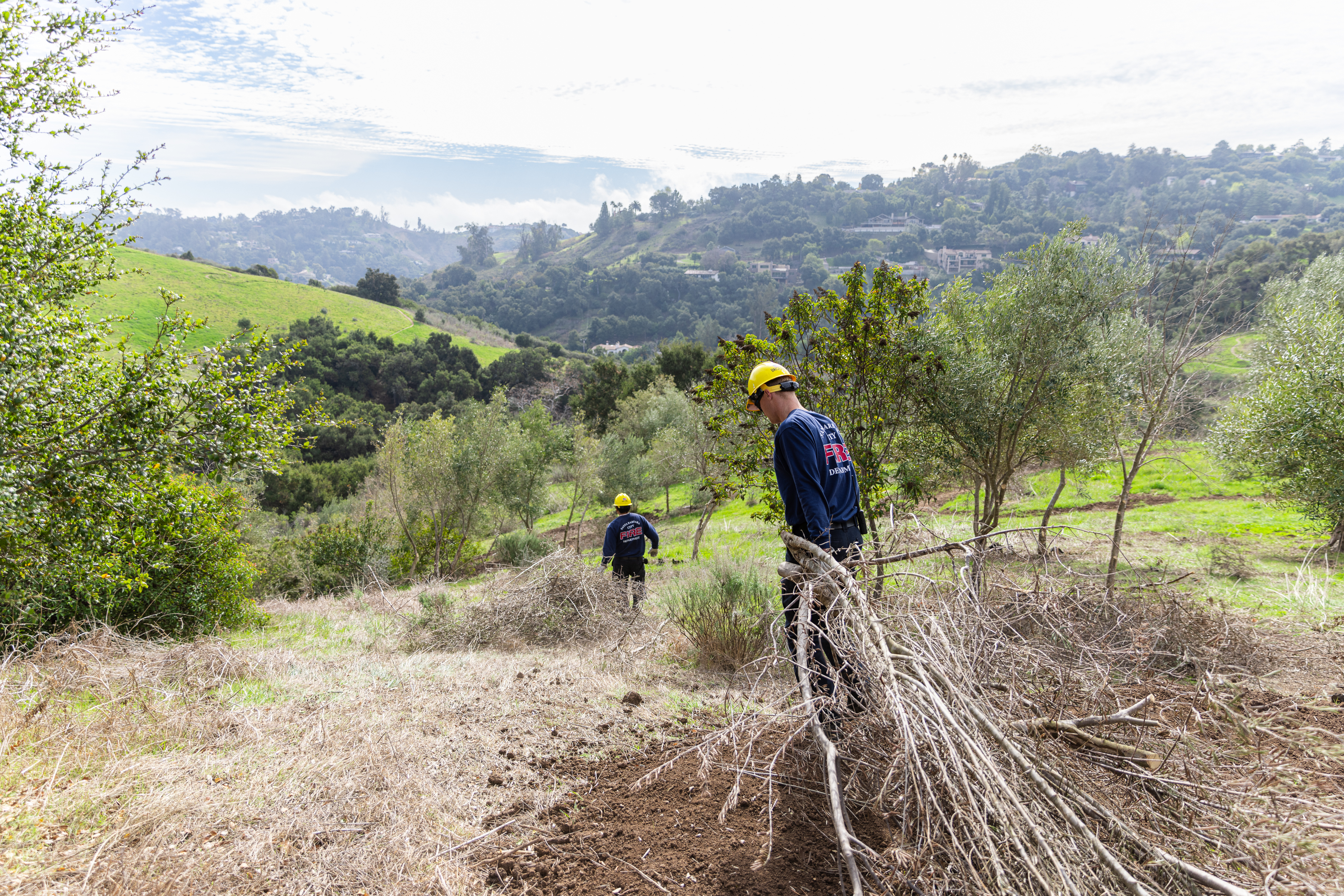
Project Dates: October 2023 through January 2024
About the Park
Parma Park is a 200-acre open space park located within the extreme foothill zone of the high fire hazard area. The park is composed of twelve different vegetation communities. The native bigpod ceanothus chaparral community makes up a majority of the park space, followed by the coast live oak woodland and forest community.
Completed Work
Crews targeted invasive species and deadwood to reduce fuel loads in the park through weed whipping, hand cutting, hand pulling, chainsaw work, chipping, flattening, raking, and shoveling. Crews assisted with annual defensible space work, preparation for native habitat restoration, and pruning of the historic olive grove within Parma Park. Targeted invasive species included bristly ox-tongue, acacia, canary island date palm, non-native annual grasses, eucalyptus, Peruvian pepper, olive, onionweed, cape ivy, French broom, thoroughwort, cotoneaster, euphorbia, and milk thistle.
Crews also focused on removing vegetation from trails, also known as trail brushing, to maintain clear site access for emergency crews and vehicles in the event of a fire.
Sensitive Resources
A biological resource assessment was performed and identified a variety of sensitive resources within the park.
Seven special status plant species were identified: Plummer’s baccharis, Southern California black walnut, Santa Barbara honeysuckle, Catalina mariposa lily, Hoffmann’s sanicle, white-veined monardella, and bitter gooseberry.
Eight special status wildlife species are considered likely to be found within the park: Southern California rufous-crowned sparrow, Crotch’s bumblebee, olive-sided flycatcher, willow flycatcher, southwestern willow flycatcher, merlin, American peregrine falcon, and western red bat. Cooper’s hawk is known to be present within Parma Park.
A pre-activity biological survey occurred within 10 days of the start of work for all special status species. Exclusion zones and a biological monitor were utilized to protect all special status species on site. Work was performed outside of nesting bird season.
Two sensitive natural communities are present within the park: needle grass – melic grass herbaceous grassland and California sycamore – coast live oak riparian woodlands. No adverse impacts were made to these communities and invasive vegetation that threatens these sensitive communities was targeted.
All crew members received environmental awareness training before work began to review present sensitive resources and how to protect them.
Parma Park Biological Resource Assessment (November 2023)
Parma Park Work Plan (May 2024)
Parma Park After Action Report (May 2024)
Project Dates: October 2023 through December 2023
About the Park
Honda Valley Park is a 48-acre open space park located within the coastal interior zone of the high fire hazard area. The park has diverse, dense vegetation along steep slopes and within canyons, as well as a heavy understory of invasive plants and thatch.
Completed Work
Crews targeted deadwood and invasive species to reduce fuel loads in the park through weed whipping, hand cutting, hand pulling, chainsaw work, chipping, flattening, raking, shoveling, and bucking existing woody debris. Targeted invasive species included mustards, non-native annual grasses, pampas grass, eucalyptus, bigleaf periwinkle, Peruvian pepper, onionweed, nasturtium, English ivy, cape ivy, tree tobacco, French broom, thoroughwort, bullthistle, African asparagus fern, and Victorian box.
Crews also focused on removing vegetation from trails, also known as trail brushing, to maintain clear site access for emergency crews and vehicles in the event of a fire.
Sensitive Resources
A biological resource assessment was performed and identified a variety of sensitive resources within the park.
Four special status plant species were identified: Plummer’s baccharis, Southern California black walnut, Santa Barbara honeysuckle, and bitter gooseberry. A biologist was onsite to monitor when work was occurring within 50 feet of the mapped special status plants.
Six special status wildlife species are considered likely to be found within the park: Cooper’s hawk, sharp-shinned hawk, California legless lizard, overwintering monarch butterfly, American peregrine falcon, and western red bat. A pre-activity biological survey occured within 10 days of the start of work for all special status species. Exclusion zones and a biological monitor were utilized as needed when special status wildlife were observed. Work was performed outside of nesting bird season.
Two sensitive natural communities are present within the park: lemonade berry scrub shrublands and California sycamore – coast live oak riparian woodlands. No adverse impacts were made to these communities and invasive vegetation that threatens these sensitive communities was targeted.
All crew members received environmental awareness training before work began to review present sensitive resources and how to protect them.
Funding
This project is funded by a Coastal Conservancy Grant.
Honda Valley Park Biological Resource Assessment (September 2023)
Honda Valley Park Work Plan (December 2023)
Honda Valley Park After Action Report (May 2024)
Community Meetings
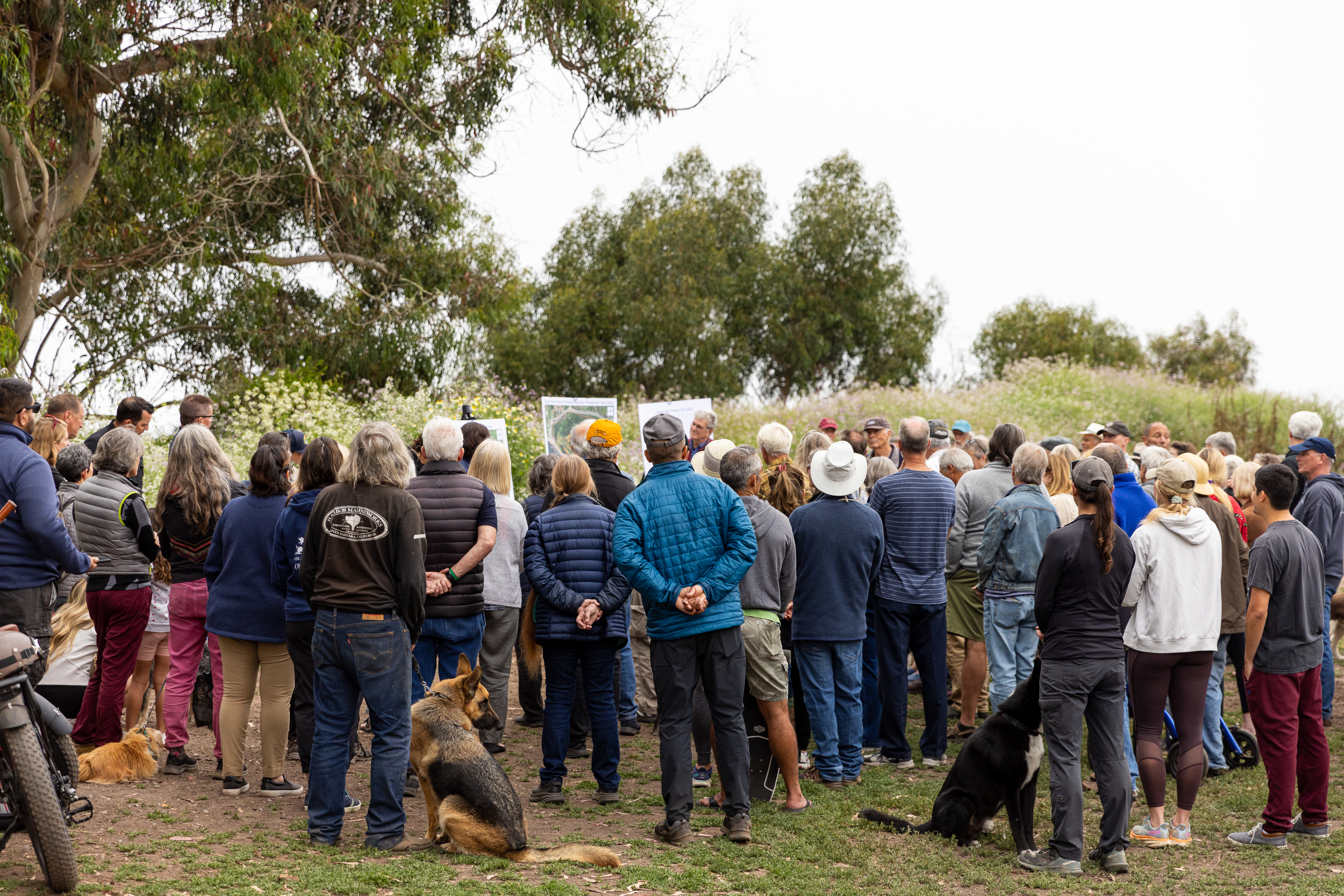
Join Fire and Parks and Recreation staff to learn more about our upcoming projects. Hear about the unique hazards and sensitive resources within each open space and share your thoughts to help guide our future work plans.
Past Meetings
September 13, 2023 - Honda Valley Project
January 4, 2024 - Parma Park Project
June 5, 2024 - Douglas Family Preserve Project
July 17, 2024 - Elings Park Project
September 18, 2024 - Douglas Family Preserve Project
December 5, 2024 - Franceschi Park Project
August 26, 2025 - Stevens Park Project
October 16, 2025 - Franceschi Park Invasive Plant Removal
Funding
Historically, City Fire crews and Parks and Recreation staff have not had the resources for a comprehensive approach to fire safety across open spaces. Through ongoing collaboration, the Departments have secured nearly $4.5 million in grant funding to support wildfire resiliency efforts.
In February 2023, the Coastal Conservancy awarded the City of Santa Barbara a $525,000 grant to support wildfire prevention and resilience efforts. This grant, in addition to $87,800 match funding from the Fire Department, will cover comprehensive biological resource reports in seven open space parks to inform future work plans, and the execution of work plans in three of seven of the parks.
In October 2023, the City of Santa Barbara was awarded an approximately $2.9 million CAL FIRE grant to support hazardous fuels management in the remaining parks, plus additional open space areas. The grant will allow for biological assessments to be conducted in 11 additional locations and work plans to be executed in 15 open space areas.
In April 2025, the Coastal Conservancy awarded the City of Santa Barbara a second grant of $950,000 to build upon the work and previous success of the Wildfire Resiliency Project, specifically supporting native habitat restoration efforts. This grant, in addition to $64,000 in matching funding from the Parks and Recreation Department, will expand the removal of invasive, non-native species in six parks and support active restoration in three parks.
This funding will be used in open spaces across the City including Arroyo Burro Open Space, Barger Canyon Preserve, Cold Spring Trail and Gould Park, Douglas Family Preserve, Equestrian Circle, Escondido Park, Franceschi Park, Hale Park, Hidden Valley Park, Hilda Ray Park, Honda Valley Park, Jesusita Trail Corridor, La Mesa Park, Laurel Canyon Park, Loma Media Park, Mission Historical Park, Orpet Park, Parma Park, Rattlesnake Canyon Trail Corridor, Sheffield Reservoir, Skofield Park, Stevens Park, and Sylvan Park.

